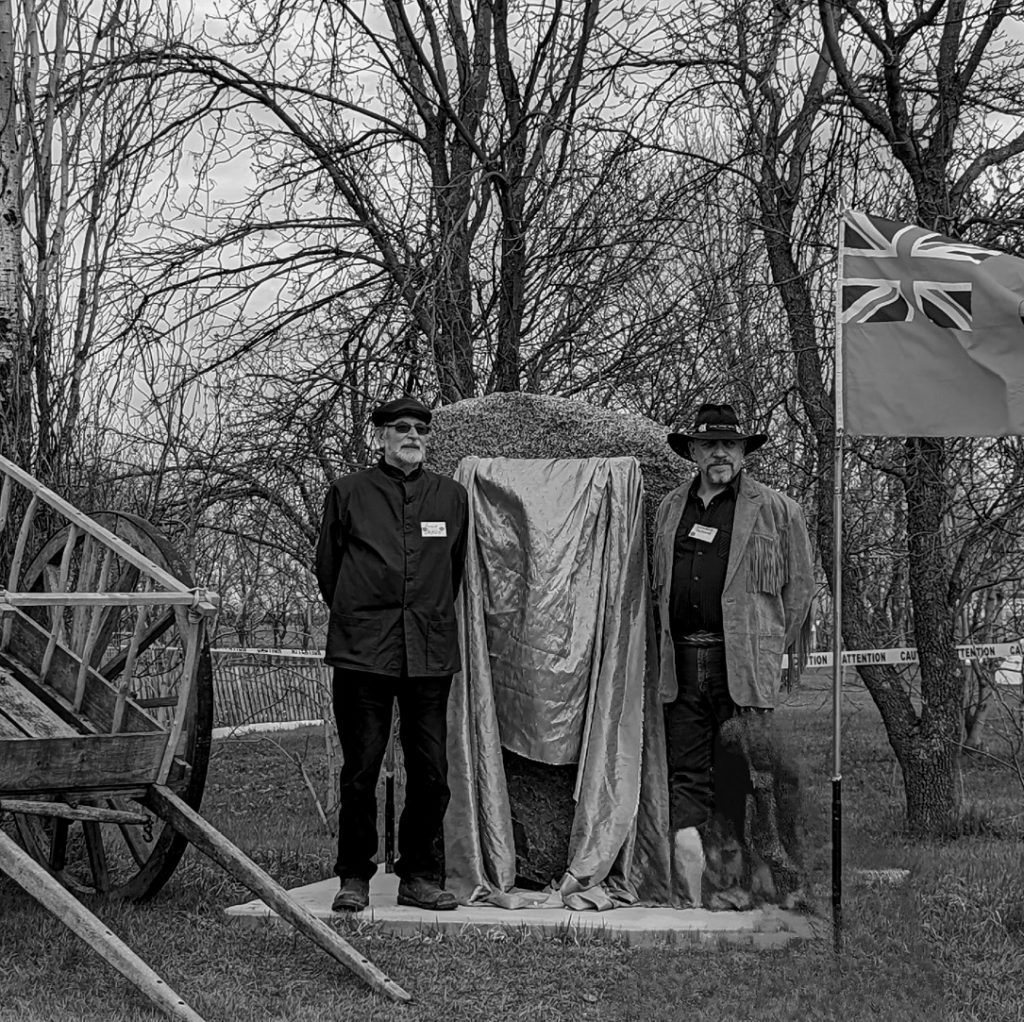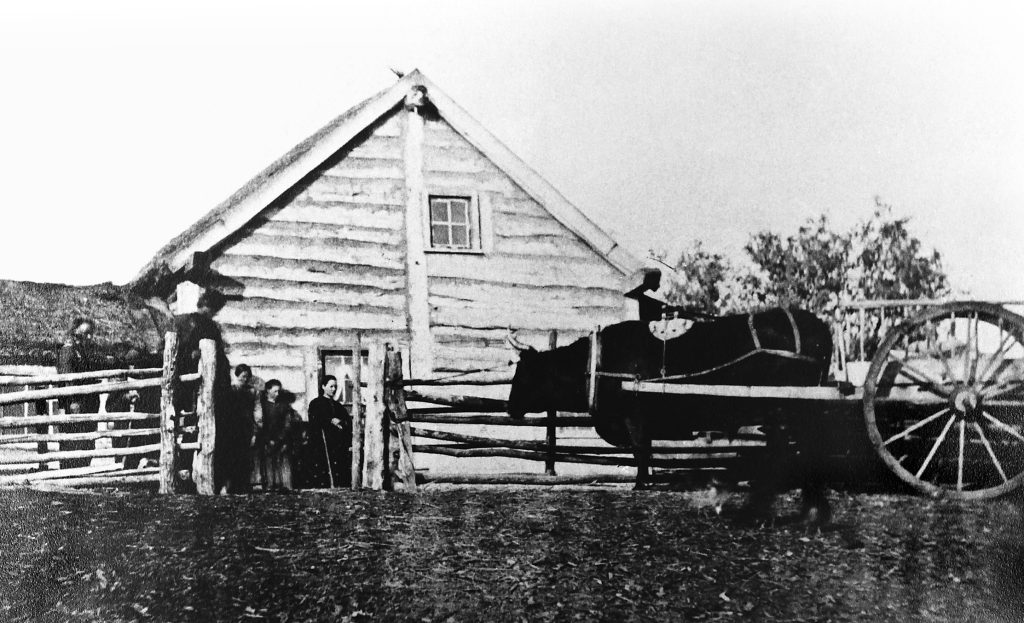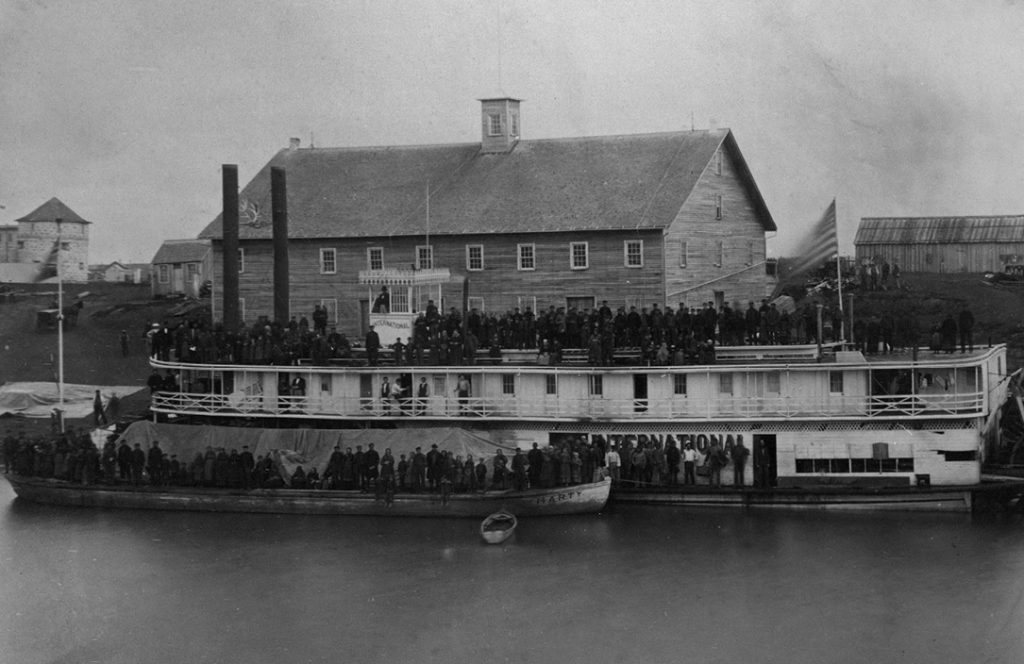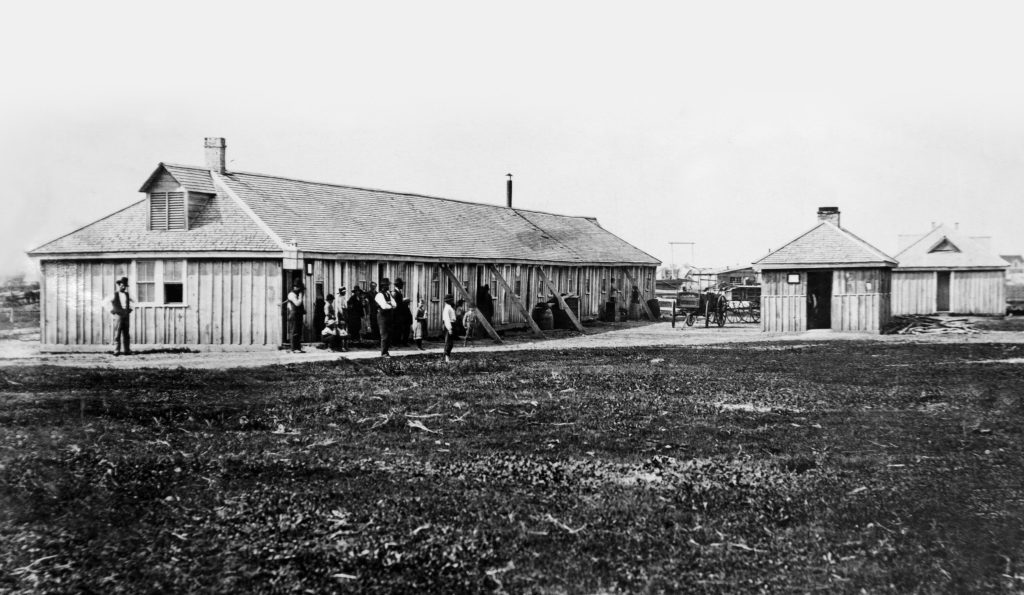A Métis-Mennonite Encounter: The Shantz Cairn
EastMenn Historical Committee
On May 12, 2022, the EastMenn Historical Committee unveiled the Shantz Cairn at the historic site of the Shantz immigration sheds. Armand and Kelly Jerome, master Red River cart builders, who brought a cart replica for the event, gave a speech on the lifestyle and culture of the Red River Métis. After their speech, Don Thiessen led the group in the singing of “Now Thank We all our God” (Nun danket alle Gott), first in English and then in German. During the German version, Armand Jerome, representing the Métis who built the sheds and brought the Mennonite immigrants from the Rat and Red River landing, and Ernest N. Braun, representing the Mennonites, carefully unveiled the plaque. Braun then delivered his speech, “Campfire to Hearth.” The program ended with Christian Mennonite Conference Bishop Dave Reimer dedicating the cairn and giving a closing prayer. The following are condensed versions of the event’s main speeches.

The Red River Métis
Good afternoon everyone, and welcome here on Manitoba Day. My name is Armand Jerome. I am a Métis Red River Cart builder, and next to me is my wife and cart assistant Kelly Jerome. We would like to thank our dear friend Ernie Braun for asking us to participate in today’s event
We feel honoured and privileged to be included in this most important ceremony honouring the beginnings of the Métis and Mennonite journey.
Approximately twenty years ago, on my first cart journey to the Manitoba Indigenous Summer Games in Winnipeg, the Crow Wing Trail representatives approached the group I was involved with, asking that we journey their trail. A short time later, reps from the Mennonite Landing Site committee requested that we do a reenactment of the 1874 Mennonite landing during our ride. This extra adventure was received with great enthusiasm by our cart group, as well as from both the Mennonite community and Crow Wing Trail members. It was a great success.
The cart you see before you is all that remains of the carts we used on that journey and we so proudly display it to you today.
Little did I know at the time that I’d be standing here twenty years later celebrating another historic marker honouring both Mennonite and Métis heritage. I sincerely hope that the continued sharing and celebration of our two cultures continues into the future. In this way we learn and grow with one another.
Ernie Braun has asked us to discuss how we build and drive our Red River carts and to provide some insight into the deep connection between the Métis and Mennonite peoples. The events of 1874 mean Red River carts played a huge part in your culture and history here in Manitoba, too. They are, in fact, the tie that binds our two cultures forevermore.
The cart you see here today would have been very close to the carts that the Métis would have used in bringing the Mennonites to the Shantz sheds that are being honoured here today. My Métis ancestors would have done all they could to help with the first harsh winter by supplying deer meat, teaching traditional medicines to help with illness, and demonstrating survival skills.

Prior to the arrival of the Mennonites, the Métis lived in this area, as indicated by names such as Tourand, St-Pierre-Joly, St. Adolphe, and Île-des-Chênes. Their housing would have consisted mostly of log cabins, as their culture was quite advanced for the time. They would have made a living by farming, freighting, trapping, droving, and in gathering buffalo bones for use in the manufacture of fertilizer and refining sugar. Their existence focused on day-to-day survival, as life was harsh and could be cruel.
The Métis people were a resourceful, talented, and deeply hard-working people. Métis men were well known for how tough they were and feats of great strength were not uncommon. For example, during buffalo hunts a Métis man would take his horse at a full run steering only with his knees, while holding his musket upright in order to spit musket balls into the end, keeping the musket in the upright position until parallel to a buffalo, at which time he would very quickly drop the muzzle into position to fire. In winter, if a dogsled or carriole became bogged down, the men would dawn their snowshoes and run in front on the dogs, breaking trail
The Métis women could also hold their own in hard work. During traditional hunts they generally walked with the children following the hunters, and it was their job to skin the buffalo, prepare the meat for pemmican, and tan the hides that would then be used to create their clothing – the most famous of Métis clothing would be the elaborate beaded buckskins and dresses. The Métis hunts would consist of approximately a thousand Red River carts and hundreds of Métis families. The amount of work required to pull all this together is astounding. These hunts determined their winter survival. The Métis riders were so skilled that much of the trick-riding they did to practice prior to a hunt was adopted by the RCMP Musical Ride you see today
Besides the amazing beaded articles the Métis created, there were the traditional sashes you see Métis people wearing to this day. These take about an hour an inch to finger-weave, and the sash is about eight feet long. The colours and beads on each sash represent where the Métis family comes from, how many children they have, and their ancestry. A symbol of the Métis nation is the infinity flag, the oldest Indigenous flag in Canada
I’ve been building carts for over twenty years now, and my wife Kelly, who is of Ukrainian descent, has joined me in this venture for the last thirteen of those. Being a citizen of Métis ancestry, I have been involved with the promotion and display of Métis culture for a number of years now. Canada is presently in a period of a resurgence of Aboriginal culture, which consists of First Nations, the Inuit and the Métis Nation. Having played a part in this resurgence, I’ve seen the revival and restoration of our music and dance, beadwork, the language, and other aspects of the Métis culture that make it distinct from all others. My part in all this has been to revive the craft of building Red River carts, which I have researched and tested by trial and error over the years.
The carts we presently build take about four hundred hours from beginning to end, including acquiring the woods needed, curing, milling, construction, and final coating. This for us is a labour of love.
The Red River cart is similar to many two-wheeled carts seen around the world, but the technology of its construction that suited the seclusion of the Red River area and the lay of the land makes it unique from all others. As the area was landlocked and without any roads to transport heavy metals and machinery, the people needed a vehicle that could be constructed using local woods, and that could withstand an unforgiving terrain. This cart was constructed of local hardwoods such as oak or ash for the wheels and body, elm for the hubs, due to its resistance to cracking, and willow or birch for the basket. The wheels were over five feet high, allowing it to cross most shallow streams, and dished to add stabilization to the cart over uneven terrain. It had a tapered axle that was tapered only on three sides to allow proper alignment for dished wheels, and heavy-duty bolsters that had multiple duties, such as holding down floor boards as well as an anchor for basket corner supports, to bring incredible strength to the basket. No metal parts were used in its construction, and every part was held together with dowel or rawhide. Some call it an oxcart, but in truth other animals like horses and mules were also used.
We have travelled by cart thousands of miles across Manitoba and Saskatchewan, with the longest journey being approximately eight hundred miles by trail from south Winnipeg to Batoche, Saskatchewan, over nine weeks. We used mainly horses but the odd time an ox, the reason being a horse travels between four to six miles an hour and can cover up to thirty miles a day, while an ox averages two miles an hour, so even ten miles a day becomes a challenge. Though an ox has strength for heavy loads, the horse has the distance advantage. On our journeys we keep the distance at fifteen to twenty miles a day to reduce the hardships.
The most cherished thing we walk away with after these journeys is a deep understanding of what my Métis ancestors had to overcome, and the bringing together of all the various cultures we encounter on the trail, from First Nations to Hutterites, Mennonites, and the local people from each community we pass through – and at one point, visiting Europeans, who took back with them tremendous stories of their experience with us. We sit in sharing circles each night and deeply encourage people to discuss their cultures and historic stories. In this way we learn and understand and move forward in acceptance of one another.
—Speech by Armand Jerome
Campfire to Hearth
About twenty-five years ago a small group of Mennonites set up a large marble stone at the Rat and Red River landing, and in 2019 another small group erected this stone here.1 Today I want to ask: What do these stones mean? I will try to answer that question as if our grandchildren were standing here and wondering. I don’t claim to know everything about it, but I will try in broad strokes to identify two significant aspects of that meaning, aspects that are almost at odds with each other.
The first most of us already know, although our grandchildren may not. Mennonites arrived here in the mid-1870s from what is now Ukraine (then New Russia) as a result of social, economic, religious, and political upheaval in their home country. By the early 1870s, having lived there for almost eighty years, they were faced with a number of changes by the government, changes they thought would affect every aspect of their lives, especially their understanding of how they should live out their Christian faith: specifically, how to love your enemy.

Having enjoyed an exemption from military service during their time in the Russian empire up to that point, it appeared Mennonites would now lose it, and their young men (if selected) would, within a decade, need to spend four years in military service to the country, although this requirement was quickly converted to alternative service. Moreover, the language of school and colony administration would become Russian, and Mennonites would be assimilated into the great Russian empire. Moreover, landlessness, social and religious differences, and other factors precipitated a need for new space to settle in the early 1870s. Coincidentally, the new province of Manitoba, created in 1870, desperately needed reliable settlers for the land to establish Ottawa’s claim to the new territory, and at least in part to ward off American expansionism.
The end result was that between 1874 and 1880, about seven thousand Mennonites arrived in Manitoba, half of them coming to the East Reserve. This stone, this cairn, is a reminder of that arrival, and a way of honouring the man who made it all possible. At the Canadian government’s behest, Jacob Y. Shantz, a middle-aged Mennonite businessman from what is now Kitchener, Ontario, came to Manitoba in 1872 for an exploratory trip, and wrote back to the minister of agriculture in Ottawa that the emergent province of Manitoba would be a good place for Mennonite farmers to settle in block settlements.
His involvement did not stop there: Shantz wrote a pamphlet about the journey in German, and it was distributed widely among the Mennonites in imperial Russia. Then he accompanied the Mennonite delegates in 1873 as they toured the province. When it became clear that settlers would actually arrive in 1874, Shantz contracted with the federal government to construct immigration sheds in exchange for four quarter-sections of land on which they would be built. At first, he selected four quarters two miles from here, but when that did not work he chose quarters 17, 18, 19, and 20, intersecting right where the cairn now stands. He bought the timber in Minnesota to be rafted down the river to the confluence of the Rat and Red Rivers. When it finally arrived in late June of 1874, he employed a group of local Métis men to build the four sheds. They were slapped together with no foundation, no floor, no shingles on the roof, so that it always rained a little longer inside than outside. Each shed was twenty feet by one hundred feet, and divided into twelve sections, six on each side, with a communal dining area in the centre, together accommodating forty-eight families at a time. He invested $3,000 of his own money, and received land valued at $640 in return.

Just days after the buildings were done, the first group of settlers arrived at the Rat and Red landing site by steamboat from Moorhead (Minnesota). Again, it was the go-to people of the day, the Métis, who carted the luggage and the elderly or infirm the five miles to the sheds. It took three days to haul everything from the riverbank for that one boatload. Women and children lived in the immigration sheds here, while Métis carters who knew the area took the men across the reserve to see the land for which they would apply for a homestead, and to lay out villages in which to build houses. Then the men would return to fetch their families, and allow later immigrants to use the same buildings for the same reason, this continuing for three years.
During that first year almost 1,500 Mennonites arrived in successive waves, most of them using the sheds at least temporarily. Some overwintered here, placing sod against the outside walls, and grass bundles on the roof, and boarding the inside so that the Free Press claimed they had “perfectly warm rooms.”2 Even more arrived in 1875, although later that year, two sheds were dismantled to build a warehouse instead, since people who bought things in Winnipeg needed temporary storage until their houses in the villages were completed.
Life in the sheds came at the end of a long six- or seven-week journey, the accumulated stress of which was revealed in the death of many children either in the sheds or on the boat prior to landfall. Several adults died as well. A total of over thirty-five burials have been identified as having taken place in the cemetery just northeast of this spot in unmarked graves still needing to be found.
By the fall of 1876 it was clear that few additional settlers would arrive, and the buildings were left standing empty. Shantz had committed to keeping the buildings available for five years, which would have been until 1879. That is also the exact time that the railway came through and made steamboat transportation obsolete. Little is known about the fate of the timber, but local lore has it that at least one barn in the area was constructed of the recycled wood.
That brings us back to our initial question: What then does this cairn now mean to the Mennonites who descended from those immigrants? Naturally, it stands for the migration itself: a migration that often encompassed everything from complete bankruptcy at one end, to opportunity for a new start at the other. Migration also meant loss for the emigrants, selling everything at fire-sale prices, leaving small children or young wives to be buried at sea or in foreign lands, breaking new land amid floods, grasshoppers, mosquitoes, and unusually hard winters and shorter growing seasons than they were used to.
While we have studied the settler experience in-depth, we have not done a good job of considering the impact of this sudden migration of thousands of Europeans to the Manitoba prairie on the peoples who inhabited that prairie, the First Nations and Métis peoples. This is the second part of the meaning of this cairn and “the rest of the story.”
The cairn reminds us that these sheds were a symbol of another traumatic dislocation. Life before European arrival on the prairies was as it had been for centuries: a life in which one expected to move across this large expanse of land, live by hunting wild game peculiar to each part of the landscape, and gather wild fruits in their seasons. A sophisticated tradition of preserving food for the winter and retreating into the forested areas to the east to shelter from the prairie winters completed the cycle. Before the Europeans came there were no cows, no domesticated poultry for meat and eggs, no horses, no hogs, not even cats for pets. That had all begun to change with the coming of the fur trade and guns around 1700, horses in the 1750s, the development of a whole new people, the Métis, and, not least, First Nation migrations from the east and from the south. The first hundred years saw the fur trade become the core of all economic activity in what is now Manitoba: Europeans dictated the value of furs for fashion in England, First Nations were wooed to trap in exchange for weapons and European goods, Métis became freighters and intermediaries as pemmican suppliers. But little agrarian settlement occurred until, with the arrival of the Selkirk settlers in 1812, that too began to change, particularly at the Forks, north along the Red River and west along the Assiniboine. By the middle of the 1800s, as Armand Jerome mentioned earlier, several parishes had already been established on other river lots where Métis and French Canadians settled as farmers, particularly as the bison disappeared and the fur trade went into rapid decline. By 1850, it was clearly the end of an era, yet by 1872, when Shantz arrived, what we know as southern Manitoba still had little evidence of settled life beyond those river lots. Surveyors working at this time found few hand-built structures on the open prairie, except some isolated Métis families who ventured out from the main rivers and settled along creeks, like the Rat River Settlement in Otterburne. Shantz reported that between the US border and what is now St. Norbert, there were no settlements at all, merely places where stagecoach horses could be exchanged along the trail.
Just two years later, the sheds were constructed, and within two more years, this land east of the Red River and north of the American border saw over thirty villages, with another twenty-five to be built within ten years. The horizon was dotted with houses, albeit primitive, with smoke curling out of the chimneys every morning.
How could this even happen? The answer is, at first gradually. By the 1850s, the lifestyle followed for thousands of years by Indigenous peoples had been radically altered by the Europeans, well before the Mennonites came. The legal framework for the changes that would follow the sheds had been crafted in Ottawa in 1870 for the Métis, which we are honouring today, and the legal framework for the First Nations was enacted at the Stone Fort one year later in 1871 as Treaty 1.
What did those legal frameworks actually mean? Up to 1874 they were largely words in an agreement, but now they assumed reality in the form of four long wooden structures, the first tangible evidence of the sudden, drastic paradigm shift that the First Nations and Métis would face. Within days of their completion, hundreds of Europeans crowded into them on their way to establishing their way of life on the prairie. This paradigm shift had no stronger symbol than what was built on this site in 1874, the largest buildings on the prairie here since the beginning of time.
But what happened to the way of life already on the prairie? The gradual transformation begun by the coming of Europeans now took a radical turn, eclipsing even the impact of the fur trade, as literally overnight hundreds of people arrived to pursue a sedentary agrarian lifestyle that would absolutely make a hunter-gatherer lifestyle impossible ever again. In just three years one would be expected to live in one place all year, get almost all one’s food from crops one had planted, and from animals one was feeding – the role of nature in supporting human life had completely changed.
The ramifications are simply enormous: this transformation is from the firepit or campfire to the hearth. The time of the campfire, a time when a cooking fire was made anywhere, was over, and the time of the hearth, where fire is made within a permanent building, had come.
One cannot imagine a more radical change. Before, people were dependent on the natural landscape to provide meat, fruit and nuts, fuel, clothing, and shelter. Success in this lifestyle depended on knowing the landscape intimately, knowing where the animals are and when, where the fruits are and when, and how to preserve them for the winter. Now, suddenly, in just five weeks, these huge sheds appeared: visible evidence of the irreversible metamorphosis to a hearth lifestyle. This perspective on the immigration sheds is indeed very sobering, and we should pause a bit and examine it. We see that with the sheds came an unimaginable transformation, complicated by factors nobody anticipated. Europeans had brought horses, guns, and disease, all with ramifications that might have been anticipated, but by then it was too late, even as the results became obvious. Moreover, with these changes gradually taking over the prairie, a new era arrived in European society too, as industrialism created a larger demand for raw materials, and suddenly new lands were urgently needed.
The new legal frameworks responded to that demand, but for both the First Nations and the Métis the result was immediate and overwhelming. The new paradigm brought a new understanding of ownership of land, a concept completely foreign to First Nations, and one that would have vast implications for their ability to travel and hunt. Moreover, the bison had been wiped out by settlement and subsequent habitat loss, and by overhunting here on the prairies, so that by the 1870s, the bison stopped being a sustainable source of food in Manitoba. Every tree cut down destroyed some habitat, every acre cleared to prove up one’s homestead eliminated it as hunting ground, and every homesteader claim caused legal barriers to travel and hunting. Moreover, the centuries-old fur trade had evaporated as Europe went on to other fads. In 1871 the First Nations of southern Manitoba were placed on small reserves as part of the treaty, along with certain guarantees, but those guarantees were at best poorly kept and in many cases ignored.
For the Métis, who had participated actively in the fur trade and were instrumental in the early settlement chapter of Manitoba, the result was every bit as traumatic as the federal government bungled the promised allocation of their Manitoba Act lands. Thousands of Métis, seeing a bleak future without land, the bison, and the fur trade, migrated westward. What took their place was everything that the sheds symbolize: the first large-block European agricultural settlement of the Manitoba prairie by Mennonites.
So, I ask, what does this cairn mean? This stone stands to remind us of how we Mennonites got here, but it also reminds us of a much larger story. May it continue to do so.
—Speech by Ernest N. Braun
